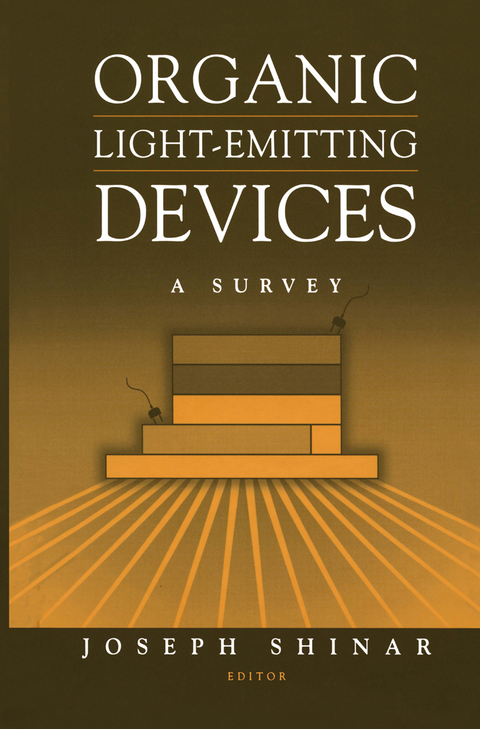
Organic Light-Emitting Devices
Springer-Verlag New York Inc.
978-0-387-95343-4 (ISBN)
Although it has long been possible to make organic materials emit light, it has only recently become possible to do so at the level and with the efficiency and control necessary to make the materials a useful basis for illumination in any but the most specialized uses. This book surveys the current status of the field.
1 Introduction to Organic Light-Emitting Devices.- 1.1 Introduction.- 1.2 Basic Electronic Structure and Dynamics of ?-Conjugated Materials.- 1.3 Basic Structure of OLEDs.- 1.4 OLED Fabrication Procedures.- 1.5 Materials for OLEDs & PLEDs.- 1.6 Basic Operation of OLEDs.- 1.7 Carrier Transport in OLEDs.- 1.8 The Efficiency of OLEDs.- 1.9 Degradation Mechanisms.- 1.10 Outlook for OLEDs.- References.- 2 Molecular LED: Design Concept of Molecular Materials for High-Performance OLED.- 2.1 Introduction.- 2.2 OLED Development from the 1960s to the 1980s.- 2.3 Working Mechanisms of OLED.- 2.4 Design of Multilayer Structures.- 2.5 Molecular Materials for OLED.- 2.6 Future Possibilities of OLED.- 2.7 Conclusion.- References.- 3 Chemical Degradation and Physical Aging of Aluminum(III) 8-Hydroxyquinoline: Implications for Organic Light-Emitting Diodes and Materials Design.- 3.1 Introduction.- 3.2 Chemical Stability of OLED Materials.- 3.3 Morphological Stability of Organic Glasses in LEDs.- 3.4 The Effect of Aging Processes on OLED Performance.- References.- 4 Organic Microcavity Light-Emitting Diodes.- 4.1 Introduction.- 4.2 Types of Microcavities.- 4.3 Planar Microcavity LEDs.- 4.4 Single Mode and Multimode Planar Microcavity LEDs.- 4.5 Intensity and Angular Dependence in Planar Microcavities.- 4.6 Materials for Organic Microcavity LED Displays.- 4.7 Summary.- References.- 5 Light-Emitting Diodes Based on Poly(p-phenylenevinylene) and Its Derivatives.- 5.1 Introduction.- 5.2 The Electronic Structure of PPV.- 5.3 Synthesis of PPV and Derivatives.- 5.4 Single-Layer LEDs.- 5.5 Multiple-Layer Polymer LEDs.- 5.6 Transport and Recombination in Polymer LEDs.- 5.7 Optical Properties of Polymer LEDs.- 5.8 Novel LED Structures.- 5.9 Prospects for Applications of PPV-Based LEDs.- 5.10Conclusions.- References.- 6 Polymer Morphology and Device Performance in Polymer Electronics.- 6.1 Introduction.- 6.2 The Control of Polymer Morphology.- 6.3 The Control of Device Performance via Morphology Control..- 6.4 Conclusions.- References.- 7 On the Origin of Double Light Spikes from Polymer Light-Emitting Devices.- 7.1 Introduction.- 7.2 Experimental.- 7.3 Results and Analysis.- 7.4 Discussion.- 7.5 Conclusions.- References.- 8 Electroluminescence with Poly(para-phenylenes).- 8.1 Introduction.- 8.2 Physical Properties of Oligophenyls and Polyphenyls.- 8.3 Electroluminescence.- 8.4 Conclusions.- References.- 9 Direct and Alternating Current Light-Emitting Devices Based on Pyridine-Containing Conjugated Polymers.- 9.1 Introduction.- 9.2 Experiments.- 9.3 Results and Discussion.- 9.4 Summary and Conclusion.- References.- 10 Polyfluorene Electroluminescence.- 10.1 Introduction.- 10.2 Synthesis and Characterization of Polyfluorene.- 10.3 Electroluminescence.- 10.4 Concluding Remarks.- References.
| Zusatzinfo | 33 Illustrations, black and white; XVI, 309 p. 33 illus. |
|---|---|
| Verlagsort | New York, NY |
| Sprache | englisch |
| Maße | 155 x 235 mm |
| Themenwelt | Naturwissenschaften ► Physik / Astronomie ► Atom- / Kern- / Molekularphysik |
| Naturwissenschaften ► Physik / Astronomie ► Optik | |
| Technik ► Elektrotechnik / Energietechnik | |
| Technik ► Maschinenbau | |
| ISBN-10 | 0-387-95343-4 / 0387953434 |
| ISBN-13 | 978-0-387-95343-4 / 9780387953434 |
| Zustand | Neuware |
| Haben Sie eine Frage zum Produkt? |
aus dem Bereich


